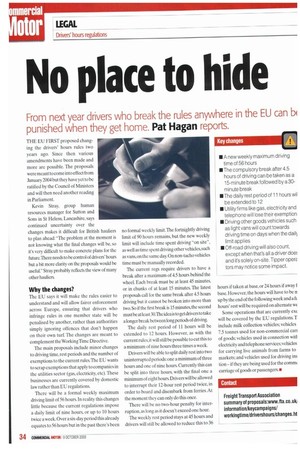No place to hide
Page 34

If you've noticed an error in this article please click here to report it so we can fix it.
From next year drivers who break the rules anywhere in the EU can b(
punished when they get home. Pat Hagan reports.
THE EU FIRST proposed changing the drivers' hours rules two years ago. Since then various amendments have been made and more are possible. The proposals were meant to come into effect from January 2004 but they have yet to be ratified by the Council of Ministers and will then need another reading in Parliament.
Kevin Stray. group human resources manager for Sutton and Sons in St Helens. Lancashire, says continued uncertainty over the changes makes it difficult for British hauliers to plan ahead: "The problem at the moment is not knowing what the final changes will be, so it's very difficult to make concrete plans for the future.There needs to be control of drivers' hours but a bit more clarity on the proposals would be useful." Stray probably reflects the view of many other hauliers.
Why the changes?
The EU says it \Ain make the rules easier to understand and will allow fairer enforcement across Europe. ensuring that drivers who infringe rules in one member state will be penalised by another, rather than authorities simply ignoring offences that don't happen on their own turf. The changes are meant to complement the Working Time Directive.
The main proposals include minor changes to driving time, rest periods and the number of exemptions to the current niles.The EL; wants to scrap exemptions that apply to companies in the utilities sector (gas, electricity. etc). These businesses are currently covered by domestic law rather than EU regulations.
There will be a formal weekly maximum driving limit of 56 hours. In reality this changes little because the current regulations impose a daily limit of nine hours, or up to 10 hours twice a week. Over a six-day period this already equates to 56 hours but in the past there's been no formal weekly limit.The fortnightly driving limit of 90 hours remains, but the new weekly limit will include time spent driving -on site". as well as time spent driving other vehicles, such as vans,on the same day. On non-tacho vehicles time must be manually recorded.
The current regs require drivers to have a break after a maximum of 4.5 hours behind the wheel. Each break must be at least 45 minutes, or in chunks of at least 15 minutes. The latest proposals call for the same break after 4.5 hours driving but it cannot be broken into more than two. So if the first break is 15 minutes, the second must be at least 30.The idea is to get drivers to take a longer break between long periods of driving.
The daily rest period of 11 hours will be extended to 12 hours. However, as with the current rules, it will still be possible to cut this to a minimum of nine hours three times a week.
Drivers will be able to split daily rest into two uninterrupted periods:one a minimum of three hours and one of nine hours. Currently this can be split into three hours. with the final one a minimum of eight hours. Drivers will be allowed to interrupt their 12-hour rest period twice, in order to board and disembark from ferries. At the moment they can only do this once.
There will be no two-hour penalty for interruption, as long as it doesn't exceed one hour.
The weekly rest period stays at 45 hours and drivers will still be allowed to reduce this to 36 hours if taken at base, or 24 hours if away 1 base. However, the hours will have to be n up by the end of the following week and a ft hours' rest will be required on alternate we Some operations that are currently exe will be covered by the EU regulations. T include milk collection vehicles; vehicles 7.5 tonnes used for non-commercial can of goods; vehicles used in connection witl electricity and telephone services; vehicles for carrying live animals from farms to markets; and vehicles used for driving ins tion if they are being used for the conune carriage of goods or passengers.•
































































































































































































